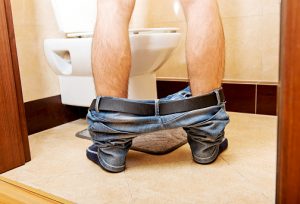
Men can experience bladder leaks as a result of an enlarged prostate. They could even end up having their prostate gland removed. As a result, men may need to wear pads in order to prevent accidents from occurring, which can really take a toll on one’s confidence.
Men who have had their prostate gland removed have the option to undergo a sling procedure if urine leaks still occur after 18 months post-surgery. A synthetic mesh is positioned accordingly in order to support the urethra.
Unfortunately, there isn’t any long-term data on the effectiveness of this procedure, but so far, 80 percent of men have been able to stop using pads or cut urinary leakage by half.
If you’re a male suffering with a constant dribble as a result of prostate problems, it is a result of the bladder not fully emptying itself. When this occurs, there’s a higher risk of bladder infections because urine remains in the bladder and bacteria can develop.
There is a class of drugs known as alpha-adrenergic agonists, which can reduce bladder contractions and reduce the urge to pass fluid.
Other medications may be prescribed to relax the prostate muscles, taking pressure off the urethra.
Another large urinary problem that occurs with aging is frequent nighttime urination. This can disrupt a person’s sleep and impair their quality of life. There are several reasons for nighttime urination—known as nocturia—including the effects of prescribed medications, fluid intake prior to bed, or taking in caffeinated beverages or foods. You may have to take a closer look at your lifestyle habits or medications in order to get to the bottom of your nocturia, so you can get back to enjoying your sleep uninterrupted.
Although bladder infections are more commonly seen among women, men, too, can develop what is referred to as cystitis. However, it’s more often prostatitis. Prostatitis is inflammation of the prostate and causes painful urination; greater urgency to urinate; cloudiness or blood in urine; and pain in the groin, abdomen, or back. It may also result in sexual problems like erectile dysfunction.
Around 10 percent of prostatitis cases result from bacteria and may also cause flu-like symptoms. In these scenarios, antibiotics are prescribed to treat it.
The most common type of prostatitis is known as chronic pelvic pain syndrome (CPPS). Although patients may experience difficulty urinating, there are no bacteria found in CPPS cases. Some experts suggest that CPPS is caused by scar tissue left behind by bacteria infection. Other theories suggest that it is caused by chronic spasms in the pelvic floor.
Treatment for CPPS includes alpha blockers, which relax the muscles and fibers in the prostate. Some patients obtain relief by taking medications used to treat erectile dysfunction and Botox injections. Some even report that frequent sex and masturbation may help reduce pain. The last treatment method isn’t clinically proven, however.
Among men, the prostate is the main culprit behind many plumbing issues. As you age, it’s important that you go for regular check-ups that include checking the prostate. Lastly, don’t be ashamed to talk to your doctor about any urine- or bladder-related problems you may be experiencing. There are many forms of treatment available for the various causes of plumbing problems, meaning you don’t need to suffer in silence.
Related: How to keep your prostate healthy